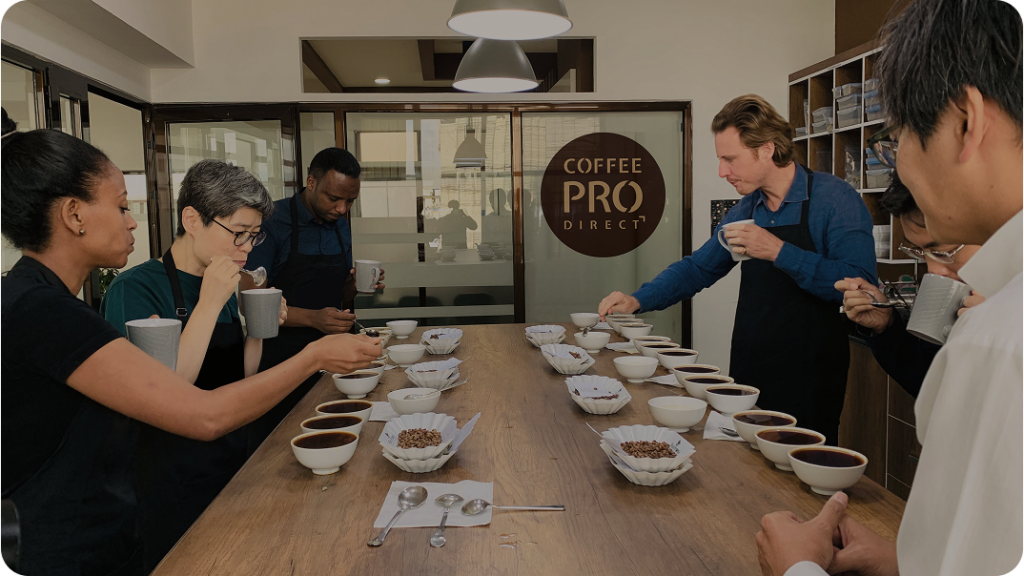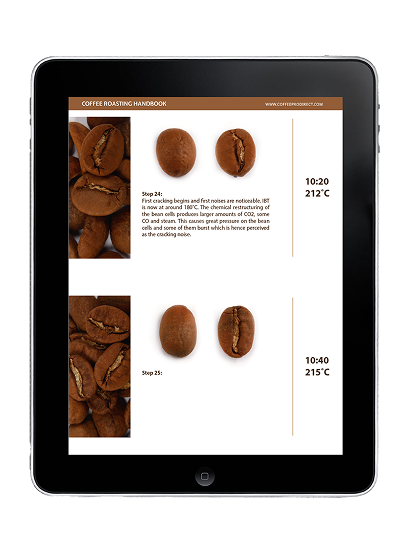Master the Art of Coffee Roasting | Coffee Pro Direct

Introduction
Roasting coffee is both a science and an art. The difference between a flat cup and an extraordinary one often lies in the precision of the roast. At Coffee Pro Direct, we’ve worked with coffee professionals across the globe—from farmers and Q-graders to micro-roasters and large exporters. This comprehensive Coffee Roasting Handbook distills years of expertise, offering a practical and technical guide for anyone serious about the craft of roasting. Whether you're just beginning or refining your production line, this 3000+ word guide is your foundation.
What Is Coffee Roasting?
Coffee roasting is the process of transforming raw, green coffee beans into the aromatic, flavorful brown beans we grind and brew. During roasting, physical and chemical transformations take place—moisture is lost, sugars caramelize, acids evolve, and volatile compounds are formed. These changes dictate the aroma, flavor, body, and overall quality of the final cup. Roasting is a delicate balance between time, temperature, airflow, and bean type.
Key Stages of the Coffee Roasting Process
Drying Phase (Yellowing)
The drying phase is crucial for preparing beans for the chemical changes ahead. Moisture content in green coffee ranges from 10–12%. The drying phase usually lasts between 4 to 6 minutes, depending on the bean density and moisture level. A slow, controlled rise in temperature allows moisture to evaporate steadily, preventing the risk of scorching or tipping. Beans transition from green to a pale yellow and emit a grassy aroma.
Maillard Reaction
This phase starts around 300°F (150°C) and is critical for flavor development. During the Maillard reaction, amino acids and reducing sugars interact to create complex aromatic compounds, including pyrazines and furans. This reaction contributes to the rich caramel and nutty notes in roasted coffee. The beans start turning light brown, and the aroma shifts from grassy to bready and sweet. Managing this phase well results in sweetness, body, and balance.
First Crack
First crack begins around 385°F (196°C) and marks a physical change in the bean. The water vapor inside the bean builds pressure until it causes the bean to pop, creating an audible cracking sound. This is the point where coffee becomes officially “drinkable.” It’s the most crucial moment to determine the roast degree. Extending development beyond first crack influences sweetness, acidity, and balance.
Development Time (Post-First Crack)
This is the phase where the roaster can either enhance or destroy the roast profile. It typically lasts between 15–25% of the total roast time. Too short, and the roast will be underdeveloped and grassy; too long, and the coffee may become flat or bitter. The goal is to allow just enough time to round out the acidity and maximize body without degrading the origin characteristics.
Second Crack (Optional)
Second crack usually starts at 435°F (224°C). It’s a louder, more violent crack and signals deeper caramelization and structural breakdown of the beans. This phase is often used for dark roasts like French or Italian. Oils begin to migrate to the surface, and the flavor becomes more roasty, smoky, or even ashy. Overextension risks carbonizing flavors and masking origin nuances.
Roast Levels Explained
Light Roast
Light roasts are typically dropped just after first crack. They preserve most of the origin characteristics, including floral, citrus, and tea-like qualities. Ideal for high-altitude and washed coffees where brightness is desirable. Light roasts have a higher density, more caffeine, and require precise brewing to extract properly.
Medium Roast
Dropped slightly later than light, medium roasts strike a balance between acidity and body. They display caramel, nut, and mild chocolate notes while maintaining subtle fruitiness. This roast level is widely used for specialty cafés and is considered a crowd-pleaser for its balance and versatility.
Dark Roast
Dark roasts are developed past the second crack. At this point, the beans lose their individual origin identity but gain uniformity and strength in flavor. Chocolate, spice, and smoky notes dominate. These roasts have lower perceived acidity and are common in espresso blends and traditional brewing styles.
Types of Coffee Roasters
Drum Roaster
A rotating drum ensures that beans tumble consistently over a heat source. Most heat is transferred via conduction (drum wall contact) and convection (hot air). Drum roasters are known for rich, complex flavor development. They are used by the majority of specialty coffee roasters and offer full control over airflow, drum speed, and gas pressure.
Fluid Bed Roaster
Fluid bed or air roasters use forced hot air to lift and roast beans in a vertical chamber. They provide a very clean, bright flavor profile and roast faster than drum machines. However, they offer less thermal momentum and often struggle with large batches. Suitable for sample roasting, home use, or experimental light roasts.
Infrared Roasters
Infrared technology heats the beans with radiant energy, allowing for rapid and even roasting. These machines are energy-efficient and can offer precision control. Infrared roasters often come with automated systems and are ideal for research labs or high-end commercial settings.
Hybrid Models
Hybrid machines combine elements of drum and air roasting to provide enhanced control and flexibility. Some models offer PID controls, smart roast profiles, and simultaneous convection-conduction heating. These are favored by advanced roasters seeking repeatability and versatility.
Essential Equipment for Roasting
-
Green Coffee Moisture Meter: To ensure uniformity and accurate charge settings.
-
Sample Roaster (100g–300g): For evaluating green coffee before buying.
-
Production Roaster (1kg–60kg): Scalable roasting solutions.
-
Exhaust and Chaff Collector System: Prevents chaff buildup and fire hazards.
-
Roast Profiling Software: Tools like Artisan or Cropster for real-time roast logging.
-
Agtron Color Reader: Measures roast color for consistency (SCA standard).
-
Cupping Kit: Essential for sensory analysis and quality grading.
Understanding Roast Profiling
A roast profile is a record of all the variables during a roast—bean temperature, air temperature, RoR, airflow, drum speed, etc. Profiling helps replicate results and identify what variables contribute to specific flavor outcomes.
Rate of Rise (RoR)
RoR measures how fast the temperature is rising. A consistent decline in RoR ensures even development. Spikes can indicate too much energy, while plateaus may suggest baked coffee.
Turning Point
This is the lowest point of the bean temperature after charging. It’s where the beans stop absorbing heat and begin rising in temperature. A critical point for roast trajectory.
Charge Temperature
Starting point of the roast, where the beans are introduced into the roaster. It influences early stage dynamics and affects drying time.
Drop Temperature
The point at which beans are released from the roaster into the cooling tray. Determines the final roast level and flavor signature.
Roast Profile Stages
-
Charge: Beans enter preheated roaster.
-
Turning Point: Minimum bean temperature.
-
Drying Phase: Moisture evaporates.
-
Maillard Phase: Flavor and color development.
-
First Crack: Audible marker of roast development.
-
Development Time: Fine-tuning phase.
-
Drop: Beans exit and begin cooling.
Factors Affecting the Roast
Bean Density
Denser beans require more energy and longer roast times. High-grown coffees often need slower, more deliberate roasts to prevent underdevelopment.
Moisture Content
Higher moisture beans take longer to roast and may require a longer drying phase. Consistent moisture content (around 11–12%) ensures predictable behavior.
Bean Size and Processing
Naturally processed beans retain more sugars and roast differently than washed ones. Smaller beans may heat more quickly, leading to uneven development if not managed.
Ambient Conditions
Room temperature, humidity, and even barometric pressure can affect heat transfer and airflow. Roasting in high-altitude areas also reduces boiling point and requires adjustments.

Roast Evaluation & Cupping
Purpose of Cupping
Cupping is the industry-standard method of tasting and evaluating roasted coffee. It allows for objective analysis of aroma, acidity, body, sweetness, aftertaste, and balance.
Common Roast Defects
-
Tipping: Burn marks on bean tips from excessive heat.
-
Scorching: Uneven black patches due to too-hot charge.
-
Baking: Dull, lifeless cup due to extended time with no RoR.
-
Underdevelopment: Grassy, papery flavors from incomplete Maillard reaction.
Cupping Protocols
Use SCA guidelines:
-
Grind size: Medium
-
Water temperature: 93°C (200°F)
-
Brew ratio: 8.25g per 150ml water
-
Break crust at 4 minutes and evaluate aroma
-
Slurp to aerate and evaluate all attributes
Best Practices for Roasting
-
Always warm up the roaster and stabilize airflow.
-
Use control batches to track equipment consistency.
-
Perform triangulation cuppings to spot flavor drift.
-
Record every roast detail—even failures provide insight.
-
Taste side-by-side against your reference roast to stay consistent.
Sustainability in Coffee Roasting
Energy Efficiency
Modern roasters now come with high-efficiency burners or electric systems. Optimizing airflow and reducing roast times can significantly lower energy usage.
Smoke and Emission Control
Afterburners, electrostatic precipitators, or catalytic converters help reduce emissions and odors, especially in urban roasteries.
Waste Reduction
Use biodegradable packaging, compost spent grounds, and recycle chaff. Many roasters donate grounds to local farmers for composting.
Scaling Up from Sample to Production
Sample roasting helps you understand the coffee’s potential. Once you have an ideal sample profile, you can scale to production:
-
Adjust for drum mass and bean load
-
Calibrate temperature probes
-
Replicate roast curve in Artisan or Cropster
-
Conduct side-by-side cuppings for alignment
Using Technology to Your Advantage
Advanced roast profiling tools allow you to save, analyze, and adjust profiles on the fly.
-
Artisan/Cropster: Real-time curve tracking
-
PID Controls: Maintain stable heat and airflow
-
IoT: Remote monitoring, alerts, and data analytics
Choosing the Right Roaster from Coffee Pro Direct
At Coffee Pro Direct, we build roasters for all stages of your journey:
-
Sample roasters (100–300g): Perfect for cupping labs and sourcing
-
Micro-roasters (1–5kg): Ideal for cafés and specialty startups
-
Production roasters (10–60kg): Built for output, consistency, and automation
Safety Considerations
-
Keep a fire extinguisher rated for electrical and grease fires nearby
-
Never leave a roaster running unattended
-
Clean exhaust weekly to avoid fire hazards
-
Conduct monthly safety checks and machine maintenance
The Future of Coffee Roasting
As demand for transparency and quality rises, roasters will continue to evolve:
-
AI-powered automation
-
Cloud-based roast syncing
-
Real-time consumer feedback on roast styles
-
Sustainable, zero-waste designs
Conclusion
Coffee roasting is a craft that rewards curiosity, patience, and precision. From understanding the chemical reactions of heat to crafting roast profiles that amplify bean potential, mastering the roast transforms your relationship with coffee. At Coffee Pro Direct, our mission is to empower roasters with the tools, knowledge, and machines to pursue quality, sustainability, and innovation. Whether you're cupping samples or filling orders for thousands, the journey begins with the perfect roast.
FAQs
How long should a coffee roast take?
A standard roast usually lasts between 8 and 15 minutes, depending on the profile.
What’s the best roast level for espresso?
Typically medium to medium-dark for balance between body and brightness.
Can I roast coffee at home?
Yes, with a small drum or fluid bed roaster designed for home use.
Is first crack always necessary?
First crack is crucial for development; skipping it usually results in underdeveloped beans.
How do I prevent baked coffee?
Monitor RoR closely and avoid stalling the roast after first crack.
- Art
- Causes
- Crafts
- Dance
- Drinks
- Film
- Fitness
- Food
- Games
- Gardening
- Health
- Home
- Literature
- Music
- Networking
- Other
- Party
- Religion
- Shopping
- Sports
- Theater
- Wellness
- Script
- App
